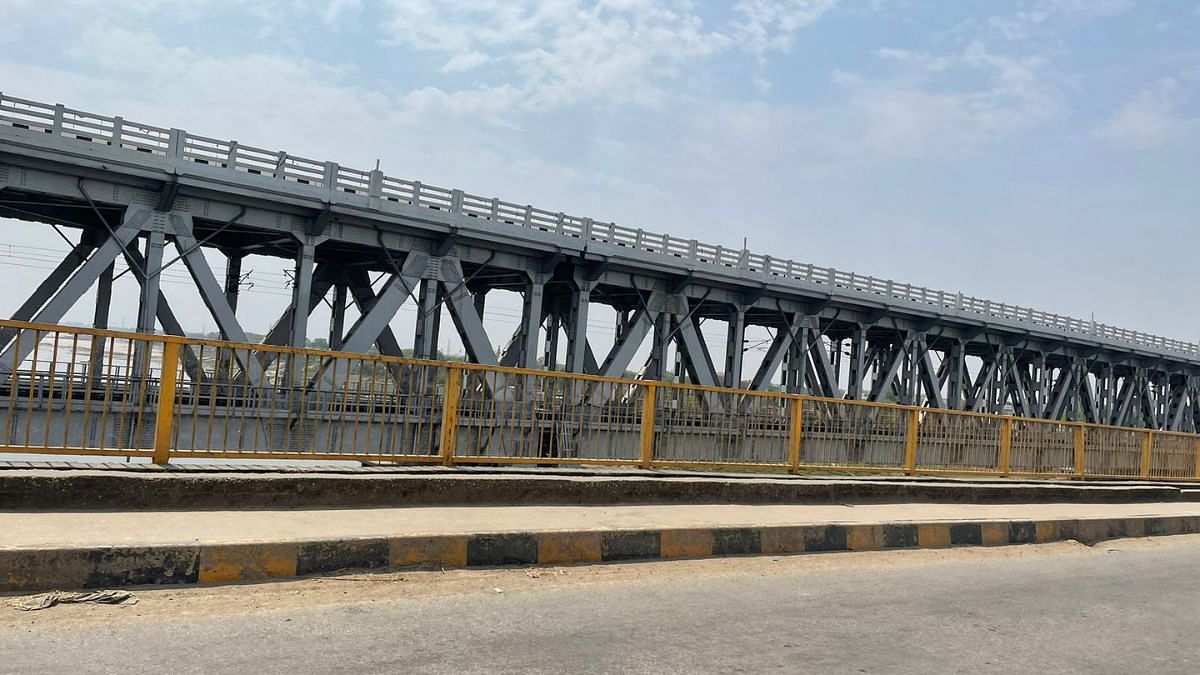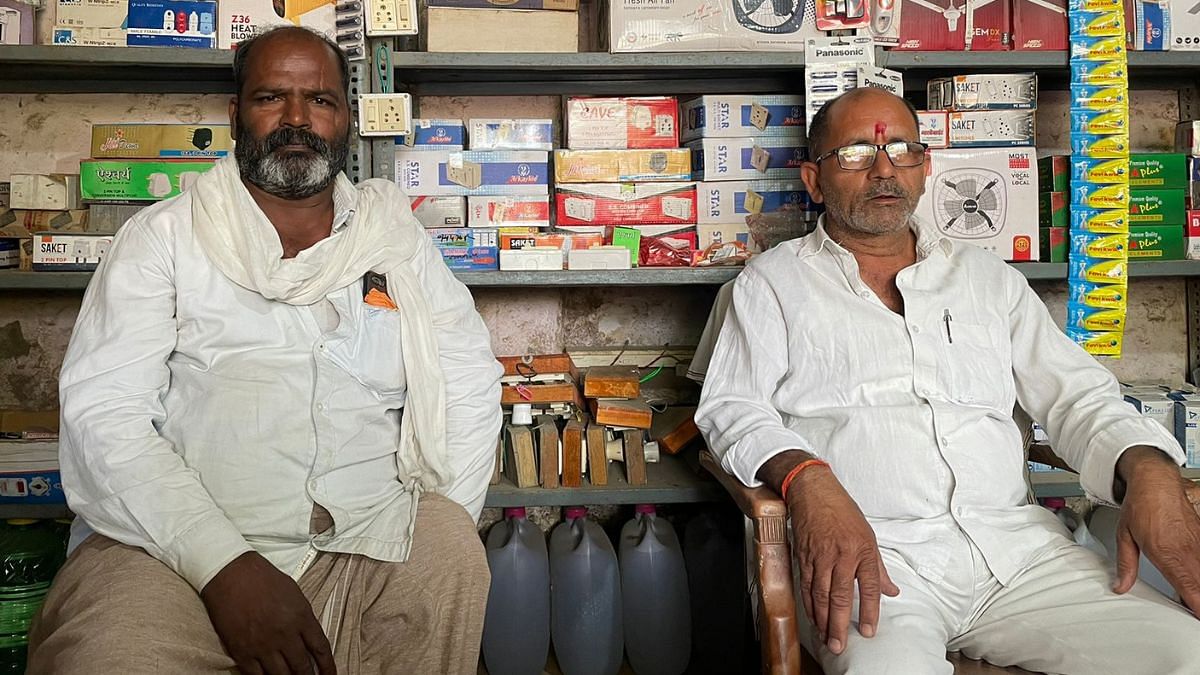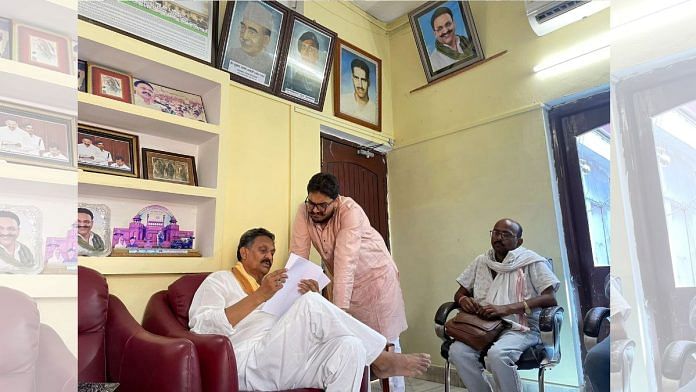Ghazipur: It is a sombre Eid at the Ansari household in Mohammadabad in Ghazipur. Afzal Ansari, the five-time MLA and two-time MP, sits in a crisp white kurta and a yellow scarf in the drawing room as a stream of supporters and mourners trickles in to condole the death of his younger brother, gangster-politician Mukhtar Ansari.
The courtyard outside the two-storey house is filled with people who are being offered fatiha ka halwa instead of the traditional Eid delicacy, sewai. “We are not celebrating Eid this time, so there is no sewai,” Afzal says.
Afzal, the sitting MP from Ghazipur and the Samajwadi Party (SP) candidate for the upcoming Lok Sabha elections, has not campaigned since 28 March, when Mukhtar died in Banda prison, allegedly by slow poisoning. The Ghazipur constituency is due to go to the polls on 1 June, in the seventh phase.
“Prachar apne aap ho jayega (the campaign will happen by itself),” he says. “You can see how angry people are…I’ll resume campaigning after 20 days (of Mukhtar’s death) nevertheless.”
It’s not just the sympathy wave for Mukhtar that makes Afzal confident about a victory in this election. It also stems from his main opponent, the Bharatiya Janata Party’s (BJP) candidate, Paras Nath Rai, a Rashtriya Swayamsevak Sangh (RSS) functionary from the region.
To most people in the Ghazipur constituency, Rai’s primary identity is of being close to Manoj Sinha, the lieutenant governor of Jammu and Kashmir, and a former MP for Ghazipur.
For most BJP supporters, the announcement of Rai’s candidature came as a dampener.
“Had Manoj Sinha been there, there would have been a fight…But now, it seems that Afzal will walk away with the election,” says Shanti Devi Jaiswal, a shop owner in Ghazipur, as she tries to search for Rai’s photograph on the internet on her phone. “He looks like an old man,” she tells her tenant, Rahul Jaiswal, who is sitting with her.
Afzal and Sinha, the two arch-rivals in Ghazipur’s politics, have had parallel political lives since the 1980s — one which explains the region’s sociopolitical landscape and answers several questions that emerge after Mukhtar Ansari’s death just weeks before the Lok Sabha elections.
Why does the gangster-politician family of the Ansaris enjoy so much social and political acceptability — both among Hindus and Muslims — in the Purvanchal region of Uttar Pradesh? Why did Sinha, popularly called the vikas purush (development man) in Ghazipur lose the election to Afzal in 2019 despite delivering a string of development projects in the constituency as the MP? And how will Mukhtar’s death play out in this election?
Also Read: Muslims must turn away from leaders like Mukhtar Ansari. They will not bring true reform
‘Baaghi kshetra’
“Kuch alag baat hai iss kshetra ki…Baaghiyon ka kshetra hai (There is something different about this region…it’s the region of the rebellious),” says Afzal, speaking of his own and his brother’s popularity in the region. “The Muslim population in Ghazipur is 10 percent. You think there would have been so much support if only Muslims supported us?” he asks.
Indeed, the politics of Ghazipur does not follow the Hindu-Muslim template of polarisation. Instead, it has been governed by the reality of extreme poverty and a strong sociopolitical narrative against samantvad (feudalism) for decades. It is this mix of crushing poverty and anti-feudal politics of resistance that first made the Ansaris so powerful.
In 1962, Vishwanath Singh Gahmari, a Congress MP, told Jawaharlal Nehru of the extreme backwardness of Ghazipur. “The people in Ghazipur are so poor that they clean and filter out the undigested wheat and gram from cattle excreta and eat it,” he is known to have told Nehru.
Deeply moved by the story, Nehru formed the Patel Committee, which recommended a slew of measures for the region’s upliftment, including a railway bridge that would connect the Ballia-Chhapra-Varanasi rail route with the Delhi-Howrah rail zone.
The construction of the railway bridge finally began in 2016 under the Modi government, with Manoj Sinha as the Union railway minister.

But it was in this backdrop of dehumanising poverty that there emerged a fiery Communist leader from the region — Sarjoo Pandey.
Pandey, a four-time MP from Ghazipur from the Communist Party of India (CPI), mobilised all the oppressed castes of the region against the landowning, upper-caste Bhumihars.
“He inculcated a sense of political and social activism in the people of the region from the 1960s,” says Dinesh Verma, a BJP leader from Mohammadabad. “The anti-samantvad politics became ingrained in the people of this region.”
There is another reason for which Pandey is now widely remembered. It was he who first groomed Afzal as a political leader in the 70s and 80s.
“Pandey was Afzal’s political guru — it was from him that Afzal picked up the politics of anti-samantvad,” Verma says. “As a result, by default, his politics became anti-Bhumihar, and he formed a support base of all castes that were oppressed by the Bhumihars.”
Sinha vs Afzal — Bhumihars vs Ansaris
“Both our fathers (his and Sinha’s) were friends; we had family ties,” says Afzal.
“Purane zamindar raees the yeh dono parivar, toh saath uthna-baithna tha hi (These two families were the old elite of this area, so there was a natural affiliation).”
He adds, “I stayed in their house for several days when both of us were taking our inter college exams. But then we both went our own ways — he joined the ABVP (Akhil Bharatiya Vidyarthi Parishad) in college and I joined the Student’s Federation (of India)…Now, the relationship is that we fight elections against each other.”
Sinha comes from a Bhumihar zamindar family, making him a natural political opponent for Afzal. He and Afzal, both upper-caste zamindars, started their political journeys around the same time, some four decades ago.
While Afzal won his first Vidhan Sabha election from Mohammadabad in 1985 on a CPI ticket — a seat he would win consistently for five elections from 1985 to 2002 — Sinha contested his first Lok Sabha election in 1984 on a BJP ticket.
While Sinha lost the election, BJP insiders in the constituency say that the fact that the party got over 60,000 votes in the constituency for the first time made the party high command notice the 24-year-old.
“Afzal had several advantages — his zamindar background made him an acceptable leader, the Communist cadres were behind him, and all the caste groups who felt oppressed by the Bhumihars came behind him,” BJP leader Verma argues. “Afzal’s politics became more and more anti-Bhumihar, and over time, the BJP became the main voice for the Bhumihars.”
Just a year after Afzal was elected as an MLA, a 23-year-old Mukhtar emerged as a criminal in the region, with the first murder case against him being lodged in 1986.
“His name was already in police records by the time for some criminal intimidation, but this was the first murder case,” says Sanjiv Kumar Grihar, a Dalit BJP leader from Mohammadabad. “He had murdered Sachidanand Rai, a local contractor, over some clash over thekedari (contract work).”
It was the BJP that protested against this, led by a local leader, Vijay Shankar Rai. With a Bhumihar BJP leader protesting against the murder of another Bhumihar, the BJP became the voice of the community in the region.
Meanwhile, Afzal kept consolidating his anti-Bhumihar support.
In 1990, Verma recalls, there was a sabha (gathering) of the Bahujan Samaj Party (BSP) in the Joga Musahib village in the Karail area of Mohammadabad.
“A group of Bhumihars attacked the sabha, and in the chaos, three Dalits died as they were running away…Afzal drew great political mileage from this incident — he tried to do an event to condole and pay homage to the Dalits,” Verma says. “The event could not take place, but he became the trusted leader of Dalits.”
In 1996, when Afzal joined the SP, the numerically dominant Yadavs rallied behind him, too.
It was this Muslim-Dalit-Yadav support that Afzal drew his political power from. “There are many Dalits and Yadavs who support them (the Ansaris) no matter which party they go to,” says Amit Jaiswal, who owns a sweet shop in Ghazipur. “Their support is because of their own popularity and goodwill.”
As Faiyaz Ahmad Fyzie, a doctor and Pasmanda activist from Ghazipur, argues, “The Ansaris are considered kings by the Hindus and Pasmandas here…Their upper-caste background makes them very acceptable as leaders in a society whose politics revolves around anti-feudalism, yet which remains intrinsically feudal in its mindset.”
Mukhtar Ansari’s bloody rise
While Afzal won election after election through the 1990s, Mukhtar’s criminality simultaneously grew ever graver and bloodier. This was an era of mafia gangsters, and Mukhtar had decidedly arrived as one.
In 1991, he was accused of killing Awadhesh Rai (elder brother of now UP Congress chief Ajay Rai) in case of a gang rivalry.
In 1993, as he sought to make his political debut, Mukhtar was accused of killing his opponent, Dalit politician Vishwanath Ram Munib, who was the BSP candidate from the Mau Sadar assembly.
In 1997, he was accused of killing a local BJP leader and coal contractor, Nand Kishore Rungta, after kidnapping him and taking a ransom of Rs 5 crore. Yet, in 2005, came the most sensational murder Mukhtar was accused of.
In 2002, Afzal lost his first election to the BJP’s Krishnanand Rai. On 29 November 2005, Rai, the sitting MLA, was ambushed by a group of seven contract killers allegedly led by Munna Bajrangi, an aide of Mukhtar’s who was later slain, and shot multiple times with AK-47 assault rifles.
In 2004, as a high-pitched general election battle took place between Sinha and Afzal, the polling day itself witnessed two killings — BJP worker Guddu Grihar and Sinha’s nephew, Sheshnath Rai, were both shot dead.
“I myself was kidnapped as I was BJP’s polling agent,” says Sanjiv Kumar Grihar, who has been quoted above. “Guddu Grihar who was killed was my uncle’s son…Who was all this done by? We all know,” he says.
The string of alleged murders — with several cases not even registered according to local politicians — made Mukhtar a dreaded criminal in the region.
“This was a time when Mukhtar was this region’s Yamraj — he would decide who would live and who would die,” says the BJP’s Verma.
Afzal’s political clout, meanwhile, gave Mukhtar the protection he needed from the state.
In 1996, however, Mukhtar himself won his first election from Mau — a seat he held for five consecutive terms until 2022. This, even though from 2005 till the end of his life, Mukhtar remained behind bars.
“He ran his empire from various jails,” Verma says. “Local coal contracts, arbitrating in local land disputes and seizing disputed lands, fish businesses, diesel businesses — Mukhtar earned crores and crores from various businesses.”
The ‘danvir’ mafia who everyone loved — and feared
But Mukhtar didn’t just amass this wealth. He distributed it copiously and generously.
“The Ansari family was a parallel state apparatus…Mukhtar would hold daya darbars from the jail itself,” says Jaiswal, the sweet shop owner, who himself is a BJP supporter.
“The locally oppressed would not go to the police, they (police) would go to Mukhtar, and he would get everything done — if someone needed money for a wedding, if there was a land dispute between brothers, if the police were not registering a case, one just needed to tell Mukhtar, and it would be done, and done swiftly,” he adds.
It is a sentiment corroborated by people across castes and income levels in the constituency.
“Mukhtar was the biggest danvir (philanthropist),” says Shiv Kumar Yadav, who owns an electrical shop. “He was against anyone who was against the poor…I myself have gone to jail to fix his TV and cooler. If the job was for Rs 100, he would give Rs 500,” he says.
“He was ruthless to those who oppressed the poor — Thakurs, Bhumihars or zamindars,” he adds.

“Unhone ek raja ki tarah apni praja ki seva kari hai, (he has served his people like a king),” says Raj Kumar Ram, a disabled Dalit, who is sitting in Yadav’s shop.
Asked about the several cases of murder against Mukhtar, Ram, who votes for the BSP, says, “Who does not do all this? He at least did it for the benefit of the poor…Kuch Rai sahib aur kuch Singh sahib log hain jo unka virodh karte hain, aur koi nahi (It is only some Thakurs and Bhumihars who opposed him).
Yet, it is a mix of gratitude and fear that explains Mukhtar’s bhaukal (terror) in the region.
“We could not even call him mafia at the time of his death while doing live shows from his residence,” says a local journalist. “The word ‘mafia’ slipped from my mouth while recording, and people started to gherao me. I had to instantly make it seem like I was asking a question, and not stating a fact.”
The presence of the streams of supporters who came to condole Mukhtar’s death was also a result of gratitude, fear and an ingrained obsequiousness to upper-caste landlords, argues Pasmanda activist Fyzie, quoted above. “People have to live here, so everyone wanted to mark their presence. Nobody wants to be seen as not supporting the Ansaris.”
Also Read: Gang lords like Atiq eliminated regularly in UP—It only cements ‘long-live’ mafia tradition
Mukhtar’s shadow
Several people argue that there could be a sympathy wave in favour of Afzal due to Mukhtar’s death. Pratap Singh, a local magazine owner from Gahmar village in Ghazipur for instance, argues that Afzal will win the election this time even if he doesn’t campaign, given the sympathy for Mukhtar’s death.
Yet, most people swiftly move to other issues that dominate the election discourse.
“There was a lot of development done during Manoj Sinha’s time — he got the railway-cum-road pull made, built a railway training centre, public toilets, a medical centre,” says electrical shop owner Yadav. “He lost, unfortunately; otherwise, this development would have continued.”
Despite Sinha’s well-acknowledged development record in Ghazipur when he was MP and railway minister at the Centre, the cards were stacked against him, as the BSP and SP were in an alliance in 2019. He lost the election to Afzal, who contested on a BSP ticket.
This time, the BSP is fighting alone and has chosen Dr Umesh Kumar Singh, a Thakur, as its candidate for Ghazipur. This, most observers argue, could cut into the BJP’s vote. But the numerically dominant Dalit vote (4.22 lakh approx.) would also not consolidate wholly behind the the SP-Congress alliance.
Moreover, in the last election, Om Prakash Rajbhar’s Suheldev Bharatiya Samaj Party (SBSP), which is also supported by the numerically dominant Rajbhar community of the region (approximately 1.9 lakh), was not with the BJP.
Yet, the candudature of the BJP’s Paras Nath Rai, a Bhumihar, casts a shadow on the party’s prospects, at least as of now.
“Of course, we like Modi, but one has to see who the candidate is, too,” says Amit Jaiswal. “People see who will remain in their midst, too…And Paras Nath Rai is absolutely unknown. Maybe people who are with the RSS know him, but that’s all,” he says.
A BJP worker says, “Had they (BJP) been serious about Ghazipur, they would have made someone popular as the candidate…But in this constituency, the BJP’s politics is all about Bhumihars — they have not let any other leader rise.”
“The main difference between Afzal and Manoj Sinha is that while Afzal has always stayed among the people here in his constituency, Sinha is seen as a very well-respected leader, but one who comes and goes,” the worker adds. “This time, he is not even fighting himself, so how will the party cadres feel?”
Yet, with still weeks to go for the elections, the BJP hopes that Rai will be able to build on his Sangh background and win people’s confidence.
“The Sangh is going door-to-door to tell people that the Ram Mandir is built, they should now not do anything because of which they cannot look Lord Ram in the eye,” says a local RSS worker.
(Edited by Richa Mishra)
Also Read: Gangsters Act: The controversial law behind Yogi govt’s crackdown on dons like Mukhtar Ansari



